-
 Bitcoin
Bitcoin $106,754.6083
1.33% -
 Ethereum
Ethereum $2,625.8249
3.80% -
 Tether USDt
Tether USDt $1.0001
-0.03% -
 XRP
XRP $2.1891
1.67% -
 BNB
BNB $654.5220
0.66% -
 Solana
Solana $156.9428
7.28% -
 USDC
USDC $0.9998
0.00% -
 Dogecoin
Dogecoin $0.1780
1.14% -
 TRON
TRON $0.2706
-0.16% -
 Cardano
Cardano $0.6470
2.77% -
 Hyperliquid
Hyperliquid $44.6467
10.24% -
 Sui
Sui $3.1128
3.86% -
 Bitcoin Cash
Bitcoin Cash $455.7646
3.00% -
 Chainlink
Chainlink $13.6858
4.08% -
 UNUS SED LEO
UNUS SED LEO $9.2682
0.21% -
 Avalanche
Avalanche $19.7433
3.79% -
 Stellar
Stellar $0.2616
1.64% -
 Toncoin
Toncoin $3.0222
2.19% -
 Shiba Inu
Shiba Inu $0.0...01220
1.49% -
 Hedera
Hedera $0.1580
2.75% -
 Litecoin
Litecoin $87.4964
2.29% -
 Polkadot
Polkadot $3.8958
3.05% -
 Ethena USDe
Ethena USDe $1.0000
-0.04% -
 Monero
Monero $317.2263
0.26% -
 Bitget Token
Bitget Token $4.5985
1.68% -
 Dai
Dai $0.9999
0.00% -
 Pepe
Pepe $0.0...01140
2.44% -
 Uniswap
Uniswap $7.6065
5.29% -
 Pi
Pi $0.6042
-2.00% -
 Aave
Aave $289.6343
6.02%
What does it mean that the QACD indicator fast line crosses the slow line but does not increase in volume?
A QACD fast-line crossover without rising volume may signal weak momentum, urging traders to confirm with other indicators like RSI or volume trends before acting.
Jun 20, 2025 at 12:22 pm
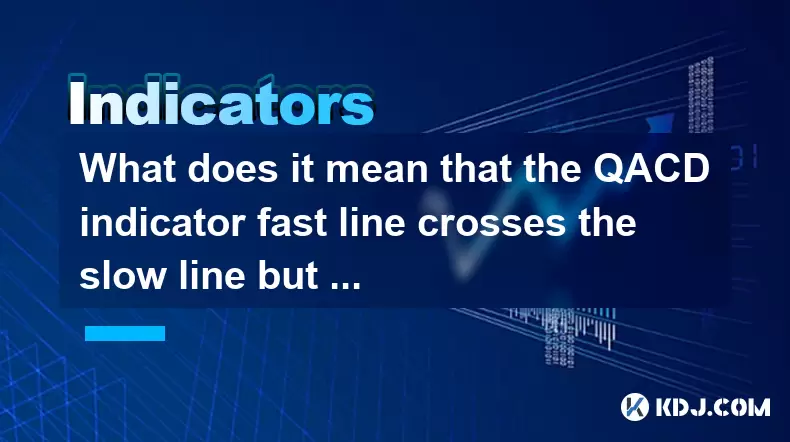
Understanding the QACD Indicator and Its Components
The QACD (Quantitative Accumulation Convergence Divergence) indicator is a technical analysis tool used by traders to identify potential trend reversals, momentum shifts, and entry or exit points in cryptocurrency markets. It consists of two primary lines: the fast line, which reacts more quickly to price changes, and the slow line, which provides a smoother, lagging perspective on market movement.
When analyzing the QACD, traders often look for crossovers between these two lines. A fast line crossing above the slow line typically signals bullish momentum, while a fast line crossing below the slow line suggests bearish sentiment. However, interpreting these crossovers without considering other market dynamics—such as volume—can lead to misleading conclusions.
What Happens When the Fast Line Crosses the Slow Line?
A crossover of the fast line over the slow line usually indicates a shift in momentum. In many cases, this can be interpreted as a sign that the asset may be entering an uptrend. Similarly, when the fast line crosses below the slow line, it might signal the beginning of a downtrend.
In the context of cryptocurrency trading, where volatility is high and trends can change rapidly, such crossovers are commonly used by algorithmic and manual traders alike to time their entries and exits. However, the reliability of these signals depends heavily on whether they are confirmed by other indicators, particularly volume.
The Role of Volume in Confirming Technical Signals
Volume is often considered the "fuel" behind price movements. In traditional technical analysis, a bullish crossover accompanied by rising volume is seen as a stronger confirmation of trend strength than one that occurs with flat or declining volume. This principle applies equally in the crypto space, where sudden surges or drops in volume can reflect institutional activity or retail trader behavior.
When a QACD fast line crosses the slow line but volume does not increase, it raises questions about the authenticity of the signal. Low volume during a crossover may suggest that the move lacks conviction from major players or that it's merely a reaction to short-term noise rather than a sustainable trend.
Possible Scenarios When Volume Doesn't Rise During a Crossover
- False Signal: The lack of volume increase could indicate that the crossover is a false signal. In such cases, the price may reverse shortly after the initial move.
- Sideways Market Conditions: If the market is consolidating, a crossover without volume might simply reflect normal oscillation within a range rather than a breakout.
- Manipulation or Whipsaw: In highly volatile crypto assets, especially altcoins, low-volume crossovers may be the result of manipulation or automated bots triggering stop-loss orders.
- Late Confirmation: Sometimes, the volume follows the price action with a delay. In this case, traders might want to wait before taking action until volume confirms the move.
Each of these scenarios underscores the importance of not relying solely on the QACD crossover without corroborating evidence from volume or other supporting tools like moving averages or RSI.
How to Respond Strategically to This Signal
When observing a QACD fast line crossing the slow line without corresponding volume growth, traders should consider the following steps:
- Wait for Confirmation: Avoid entering trades immediately. Instead, monitor if the price continues in the direction suggested by the crossover.
- Check Other Indicators: Use complementary tools like Relative Strength Index (RSI) or Bollinger Bands to confirm whether the asset is overbought or oversold.
- Analyze Timeframes: Look at multiple timeframes. A crossover on the 1-hour chart might not hold significance unless supported by a similar pattern on the 4-hour or daily charts.
- Observe Order Book Activity: For advanced traders, checking order book depth can provide insight into whether the crossover is backed by real buying or selling pressure.
- Set Tight Stop-Losses: If entering a position despite weak volume, use strict risk management techniques to limit potential losses.
These strategies help mitigate the risk of acting on what may turn out to be a deceptive signal.
Practical Example Using a Cryptocurrency Chart
Let’s walk through how to interpret this scenario using a real-world example involving a popular cryptocurrency like Ethereum (ETH):
- Navigate to your preferred trading platform and open a chart for ETH/USDT.
- Apply the QACD indicator to the chart, ensuring both the fast and slow lines are visible.
- Identify a point where the fast line crosses above the slow line.
- Observe the volume bars directly beneath the price chart at that moment.
- If the volume doesn’t rise significantly, pay attention to whether the price continues upward or stalls.
- Check the RSI indicator for signs of overbought conditions or divergence.
- If the price fails to sustain the move and volume remains flat, consider the crossover a weak signal and avoid taking a position unless further confirmation emerges.
This process allows traders to filter out less reliable signals and focus on higher-probability setups.
Frequently Asked Questions
Q: Can the QACD indicator be used alone for trading decisions?
A: While the QACD offers valuable insights into momentum shifts, it's best used alongside other tools like volume analysis, support/resistance levels, and additional oscillators to improve accuracy.
Q: How important is volume compared to price action in crypto trading?
A: Volume plays a critical role in confirming price movements. Without sufficient volume, even strong-looking candlestick patterns or indicator signals may lack sustainability.
Q: What should I do if I already entered a trade based on a QACD crossover without volume confirmation?
A: Monitor the trade closely and consider exiting if the price fails to follow through or if the next candle negates the initial bullish or bearish signal.
Q: Are there specific cryptocurrencies where low-volume crossovers are more common?
A: Yes, smaller-cap altcoins with lower liquidity often exhibit misleading signals due to thin order books and erratic volume spikes. Stick to well-established coins for more reliable readings.
Disclaimer:info@kdj.com
The information provided is not trading advice. kdj.com does not assume any responsibility for any investments made based on the information provided in this article. Cryptocurrencies are highly volatile and it is highly recommended that you invest with caution after thorough research!
If you believe that the content used on this website infringes your copyright, please contact us immediately (info@kdj.com) and we will delete it promptly.
- Filecoin, Secure Storage, and Avalanche Enterprises: A New Era of Blockchain Collaboration
- 2025-06-20 14:45:13
- SEI Price Surge: Decoding the Reasons Behind the Rise
- 2025-06-20 14:25:12
- Cryptos for the Long Haul: Early Investors' Edge in 2025
- 2025-06-20 14:25:12
- Bitcoin Price in June 2025: Riding the $100K Wave?
- 2025-06-20 14:45:13
- Tether, Stablecoins, and Public Offerings: A New York Perspective
- 2025-06-20 15:05:13
- XRP Price Consolidates as Solana Meme Coin Snorter Token Gains Traction
- 2025-06-20 15:25:12
Related knowledge

Is it a real drop when KDJ crosses but the trading volume shrinks?
Jun 20,2025 at 03:49pm
Understanding KDJ and Its Role in Cryptocurrency TradingIn the realm of cryptocurrency trading, technical analysis plays a crucial role in identifying potential price movements. The KDJ indicator, also known as the stochastic oscillator with a J line added for momentum confirmation, is widely used by traders to gauge overbought or oversold conditions. I...

What does it mean that the QACD indicator fast line crosses the slow line but does not increase in volume?
Jun 20,2025 at 12:22pm
Understanding the QACD Indicator and Its ComponentsThe QACD (Quantitative Accumulation Convergence Divergence) indicator is a technical analysis tool used by traders to identify potential trend reversals, momentum shifts, and entry or exit points in cryptocurrency markets. It consists of two primary lines: the fast line, which reacts more quickly to pri...
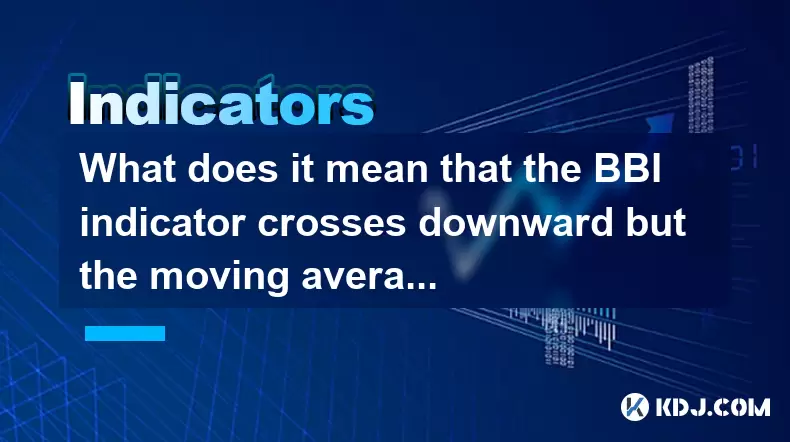
What does it mean that the BBI indicator crosses downward but the moving average does not cross?
Jun 20,2025 at 03:07pm
Understanding the Role of Blockchain in Cryptocurrency TransactionsBlockchain technology is the foundational infrastructure behind most cryptocurrencies. It serves as a decentralized, distributed ledger that records all transactions across a network of computers. This ensures transparency and eliminates the need for a central authority like a bank. Each...
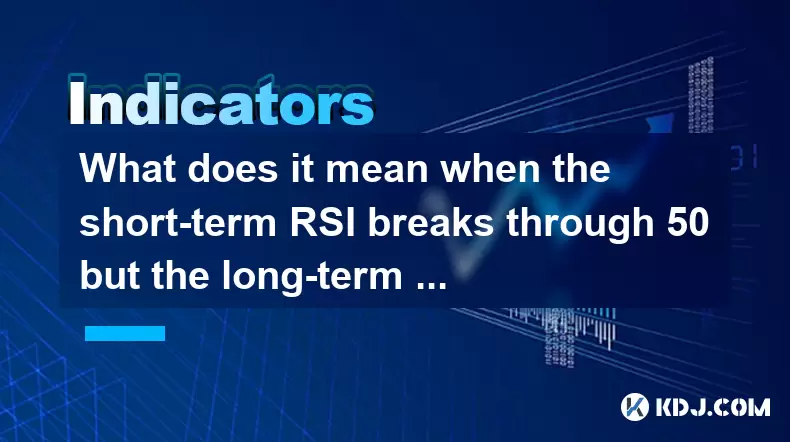
What does it mean when the short-term RSI breaks through 50 but the long-term RSI does not move in the RSI indicator?
Jun 20,2025 at 10:42am
Understanding the RSI Indicator and Its Dual-Term ApplicationThe Relative Strength Index (RSI) is a widely used momentum oscillator in technical analysis, primarily for identifying overbought or oversold conditions in an asset’s price movement. It typically operates on a scale from 0 to 100, with levels above 70 considered overbought and below 30 consid...
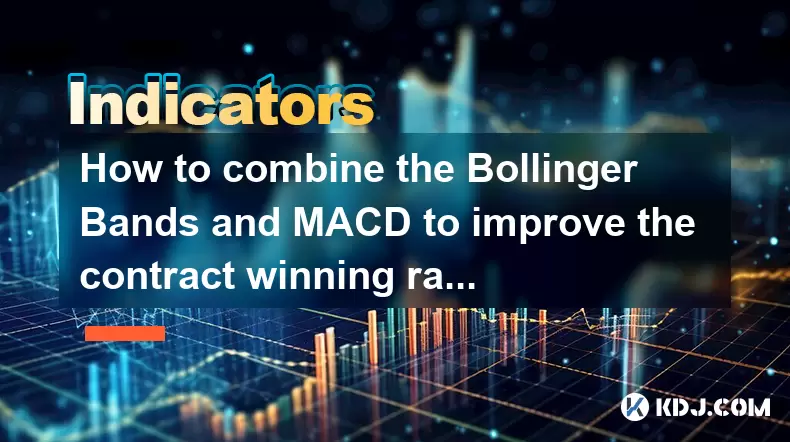
How to combine the Bollinger Bands and MACD to improve the contract winning rate?
Jun 19,2025 at 06:35pm
Understanding Bollinger Bands and MACD IndicatorsTo effectively combine Bollinger Bands and the MACD (Moving Average Convergence Divergence), it's essential to first understand what each indicator represents. Bollinger Bands consist of a middle moving average line and two outer bands that adjust based on market volatility. When prices move toward the up...
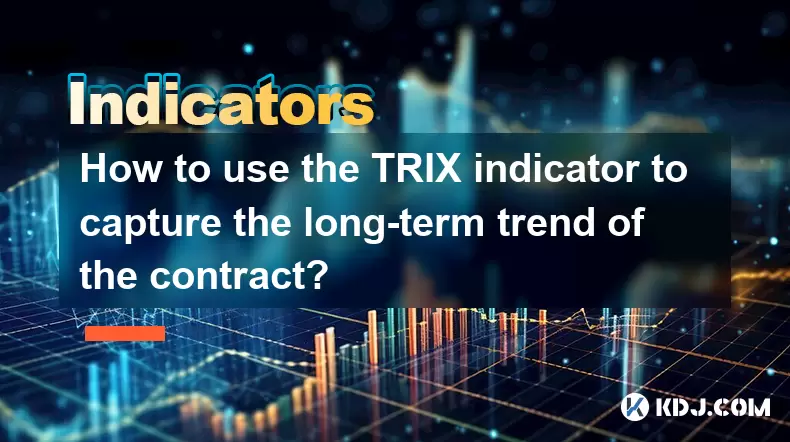
How to use the TRIX indicator to capture the long-term trend of the contract?
Jun 20,2025 at 09:14am
What Is the TRIX Indicator?The TRIX (Triple Exponential Average) indicator is a momentum oscillator used to identify oversold and overbought conditions, as well as potential trend reversals in financial markets. It is calculated by applying a triple exponential moving average to price data and then taking the percentage rate of change of that smoothed v...

Is it a real drop when KDJ crosses but the trading volume shrinks?
Jun 20,2025 at 03:49pm
Understanding KDJ and Its Role in Cryptocurrency TradingIn the realm of cryptocurrency trading, technical analysis plays a crucial role in identifying potential price movements. The KDJ indicator, also known as the stochastic oscillator with a J line added for momentum confirmation, is widely used by traders to gauge overbought or oversold conditions. I...

What does it mean that the QACD indicator fast line crosses the slow line but does not increase in volume?
Jun 20,2025 at 12:22pm
Understanding the QACD Indicator and Its ComponentsThe QACD (Quantitative Accumulation Convergence Divergence) indicator is a technical analysis tool used by traders to identify potential trend reversals, momentum shifts, and entry or exit points in cryptocurrency markets. It consists of two primary lines: the fast line, which reacts more quickly to pri...

What does it mean that the BBI indicator crosses downward but the moving average does not cross?
Jun 20,2025 at 03:07pm
Understanding the Role of Blockchain in Cryptocurrency TransactionsBlockchain technology is the foundational infrastructure behind most cryptocurrencies. It serves as a decentralized, distributed ledger that records all transactions across a network of computers. This ensures transparency and eliminates the need for a central authority like a bank. Each...

What does it mean when the short-term RSI breaks through 50 but the long-term RSI does not move in the RSI indicator?
Jun 20,2025 at 10:42am
Understanding the RSI Indicator and Its Dual-Term ApplicationThe Relative Strength Index (RSI) is a widely used momentum oscillator in technical analysis, primarily for identifying overbought or oversold conditions in an asset’s price movement. It typically operates on a scale from 0 to 100, with levels above 70 considered overbought and below 30 consid...

How to combine the Bollinger Bands and MACD to improve the contract winning rate?
Jun 19,2025 at 06:35pm
Understanding Bollinger Bands and MACD IndicatorsTo effectively combine Bollinger Bands and the MACD (Moving Average Convergence Divergence), it's essential to first understand what each indicator represents. Bollinger Bands consist of a middle moving average line and two outer bands that adjust based on market volatility. When prices move toward the up...

How to use the TRIX indicator to capture the long-term trend of the contract?
Jun 20,2025 at 09:14am
What Is the TRIX Indicator?The TRIX (Triple Exponential Average) indicator is a momentum oscillator used to identify oversold and overbought conditions, as well as potential trend reversals in financial markets. It is calculated by applying a triple exponential moving average to price data and then taking the percentage rate of change of that smoothed v...
See all articles

























































































